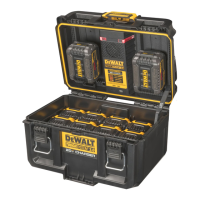ENGLISH
8
• The charger is designed to operate on standard 120V
household electrical power. Do not attempt to use it
on any other voltage.
• Foreign materials of a conductive nature, such as, but
not limited to, grinding dust, metal chips, steel wool,
aluminum foil or any buildup of metallic particles
should be kept away from the charger cavities and
ventilation slots.
• Always unplug the charger from the power supply
when there is no battery pack in thecavity.
Charging a Battery (Fig.A, E, F)
1. Plug the charger into an appropriate outlet.
2. Insert and fully seat battery packs. The red charging
light(s)
6
will continuously blink whilecharging.
3. Charging is complete when the red charging light(s)
remain(s) continuously ON. Battery packs can be left in
charger or removed. Some chargers require the battery
pack release button to be pressed forremoval.
WARNING: Only charge batteries in air temperature
over 40° F (4.5° C) and below 104° F (+40°C).
4. Charger will not charge a faulty battery pack, which may
be indicated by the charging light(s) staying OFF. Take
charger and battery pack to an authorized service center
if light(s) stay(s)OFF.
Hot/Cold Pack Delay
When the charger detects a battery pack that is too hot
or too cold, it automatically starts a Hot/Cold Pack Delay,
suspending charging until the battery pack has reached an
appropriate temperature. The charger then automatically
switches to the pack charging mode. This feature ensures
maximum battery packlife.
A cold battery pack may charge at a slower rate than a warm
batterypack.
The hot/cold pack delay will be indicated by the red light(s)
continuing to blink but with the yellow light(s) continuously
ON. Once the battery pack has reached an appropriate
temperature, the yellow light(s) will turn OFF and the charger
will resume the chargingprocedure.
The DWST08050 charger is equipped with an internal fan. The
fan will turn on automatically when a battery is being charged.
CAUTION: Never operate the charger if the fan
does not operate or if the ventilation slots are
blocked. Do not permit foreign objects to enter
the interior of the charger.
NOTE: To ensure maximum performance and life of lithium-
ion battery packs, charge the battery pack fully before firstuse.
1. Plug the charger into an appropriate outlet before
inserting batterypack.
2. To unlock the storage door
2
, flip up the door latch
handles
3
and lift and move the metal latches
4
from
the latch pin slot
5
of the storage door.
3. Open the storage door
2
to access the storage
compartment
12
and the battery charger
13
.
4. Slide the battery pack
20
onto the left or right side
charger rails
14
, making sure the battery is fully
seated. The left or right side charging light
6
will blink
continuously indicating that the charging process
Charging other types of battery packs may cause them to
overheat and burst, resulting in personal injury, property
damage, fire, electric shock orelectrocution.
• Do not expose the charger to rain orsnow.
• Do not allow water or any liquid to entercharger.
• Pull by the plug rather than the cord when
disconnecting the charger. This will reduce the risk of
damage to the electric plug andcord.
• Make sure that the cord is located so that it will not
be stepped on, tripped over or otherwise subjected to
damage orstress.
• Do not use an extension cord unless it is absolutely
necessary. Use of improper extension cord could result in
risk of fire, electric shock orelectrocution.
• When operating a charger outdoors, always provide
a dry location and use an extension cord suitable
for outdoor use. Use of a cord suitable for outdoor use
reduces the risk of electricshock.
• An extension cord must have adequate wire size
(AWG or American Wire Gauge) for safety. The smaller
the gauge number of the wire, the heavier the cord and
thus the greater its capacity. An undersized cord will
cause a drop in line voltage resulting in loss of power and
overheating. The following table shows the correct size
to use depending on total length of all extension cords
plugged together, and nameplate ampere rating. If in
doubt, use the next heaviergauge.
Minimum Gauge for Cord Sets
Volts
Total Length of Cord in Feet
(meters)
120V 25 (7.6) 50 (15.2) 100 (30.5) 150 (45.7)
Ampere Rating
American Wire Gauge
More Than Not More
Than
0 6 18 16 16 14
6 10 18 16 14 12
10 12 16 16 14 12
12 16 14 12 Not Recommended
• Do not place any object on top of the charger or
place the charger on a soft surface that might block
the ventilation slots and result in excessive internal
heat. Place the charger in a position away from any heat
source. The charger is ventilated through slots inside the
storage door.
• Do not operate the charger with a damaged cord
orplug. Have them replacedimmediately.
• If the supply cord is damaged, it must be replaced
by the manufacturer, its service agent or similarly
qualified persons in order to avoid a hazard.
• Do not operate the charger if it has received a sharp
blow, been dropped or otherwise damaged in any
way. Take it to an authorized servicecenter.
• Do not disassemble the charger; take it to an
authorized service center when service or repair
is required. Incorrect reassembly may result in a risk of
electric shock, electrocution orfire.

